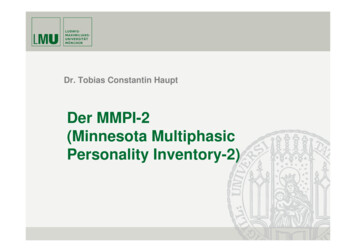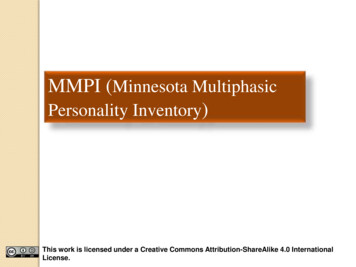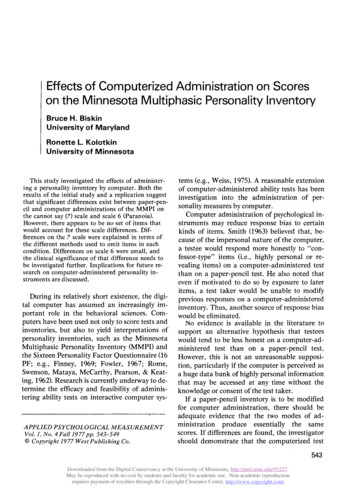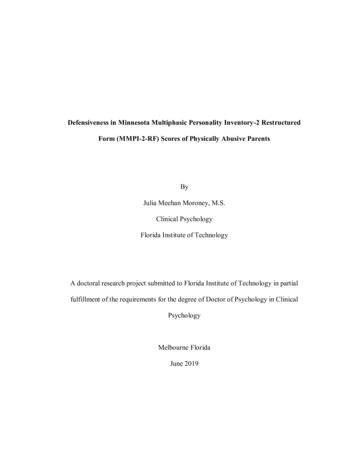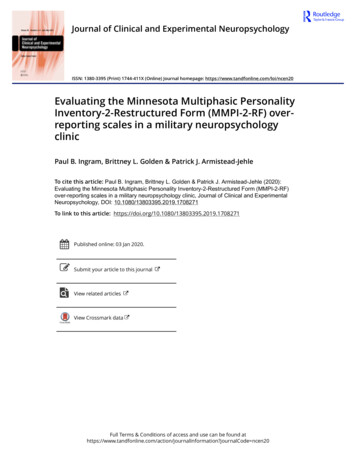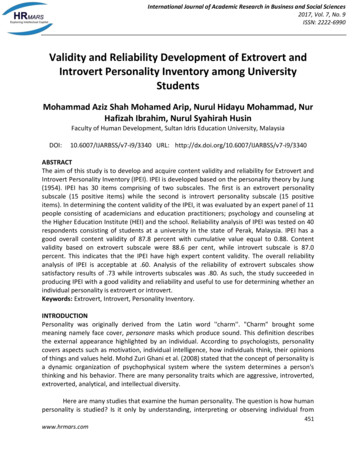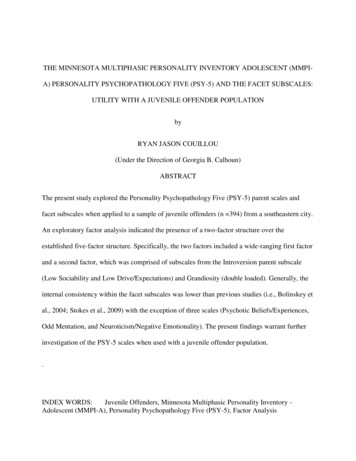
Transcription
THE MINNESOTA MULTIPHASIC PERSONALITY INVENTORY ADOLESCENT (MMPIA) PERSONALITY PSYCHOPATHOLOGY FIVE (PSY-5) AND THE FACET SUBSCALES:UTILITY WITH A JUVENILE OFFENDER POPULATIONbyRYAN JASON COUILLOU(Under the Direction of Georgia B. Calhoun)ABSTRACTThe present study explored the Personality Psychopathology Five (PSY-5) parent scales andfacet subscales when applied to a sample of juvenile offenders (n 394) from a southeastern city.An exploratory factor analysis indicated the presence of a two-factor structure over theestablished five-factor structure. Specifically, the two factors included a wide-ranging first factorand a second factor, which was comprised of subscales from the Introversion parent subscale(Low Sociability and Low Drive/Expectations) and Grandiosity (double loaded). Generally, theinternal consistency within the facet subscales was lower than previous studies (i.e., Bolinskey etal., 2004; Stokes et al., 2009) with the exception of three scales (Psychotic Beliefs/Experiences,Odd Mentation, and Neuroticism/Negative Emotionality). The present findings warrant furtherinvestigation of the PSY-5 scales when used with a juvenile offender population.INDEX WORDS:Juvenile Offenders, Minnesota Multiphasic Personality Inventory –Adolescent (MMPI-A), Personality Psychopathology Five (PSY-5), Factor Analysis
THE MINNESOTA MULTIPHASIC PERSONALITY INVENTORY ADOLESCENT (MMPIA) PERSONALITY PSYCHOPATHOLOGY FIVE (PSY-5) AND THE FACET SUBSCALES:UTILITY WITH A JUVENILE OFFENDER POPULATIONbyRYAN JASON COUILLOUB.S., The University of Georgia, 2005M.A., Western Carolina University, 2008A Dissertation Submitted to the Graduate Faculty of The University of Georgia in PartialFulfillment of the Requirements for the DegreeDOCTOR OF PHILOSOPHYATHENS, GEORGIA2012
2012Ryan Jason CouillouAll Rights Reserved
THE MINNESOTA MULTIPHASIC PERSONALITY INVENTORY ADOLESCENT (MMPIA) PERSONALITY PSYCHOPATHOLOGY FIVE (PSY-5) AND THE FACET SUBSCALES:UTILITY WITH A JUVENILE OFFENDER POPULATIONByRYAN JASON COUILLOUElectronic Version Approved:Maureen GrassoDean of the Graduate SchoolThe University of GeorgiaAugust 2012Major Professor:Georgia B. CalhounCommittee:Linda F. CampbellBrian A. GlaserAlan E. Stewart
DEDICATIONI would like to dedicate this work to my parents. They have always stood behind me as Ihave progressed academically. I will always have fond memories of how they have continuallyguided and supported me.Also, this dissertation is dedicated to my partner, Amanda, whom has been supportiveand patient. She has stuck with me through thick and thin and continues to be my emotionalrock. I continue to treasure her encouragement and love.iv
ACKNOWLEDGEMENTSI would like to acknowledge all members of my committee for their support throughoutmy years in the program. Particularly, I would like to thank Dr. Calhoun and Dr. Glaser for mywonderful personal and educational experiences as part of the JCAP team. They both have beenextremely influential in my professional development and fantastic mentors of my clinical workand with my dissertation.My thanks also go to my colleagues and classmates as they have also been a huge part ofmy experience within the Counseling Psychology program. My special thanks goes to Ashley asshe helped me immensely with data entry and has also been a wonderful friend.Lastly, I would like to thank Dr. Fong Chan at the University of Wisconsin – Madison forgenerously helping me with my data analysis. His statistical expertise was essential to my work.v
TABLE OF CONTENTSPageDEDICATION.ivACKNOWLEDGEMENTS.vLIST OF TABLES.ixLIST OF FIGURES.xCHAPTER1INTRODUCTION .1Purpose and Significance of Study.3Statement of the Problem.4Research Questions.5Definitions of Terms.62REVIEW OF LITERATURE.7Government Policies and Trends in Public Responses to Juvenile Offenders.7Present Patterns of Juvenile Delinquency.8Mental Health Patterns and Juvenile Delinquents.10Assessment and Juvenile Delinquents.11MMPI and use with Adolescents.12Development of the Personality Psychopathology Five (PSY-5) Scales.16Development of the MMPI-A PSY-5 Scales.18PSY-5 Research.18PSY-5 Facet Subscales.203METHOD. .23Sample .23vi
The MMPI-A and the PSY-5 .24Data Analyses .274RESULTS .28Mean Comparison of Normative, Clinical, and Present Samples .28Reliability of PSY-5 Facet Scales.32Hostility.33Grandiosity.33Delinquent Behaviors and Attitudes.34Norm Violation.34Low Drive/Expectations.34Low Sociability.35Psychotic Beliefs/Experiences.35Odd Mentation.35Neuroticism/Negative Emotionality.35Exploratory Factor Analysis.36Conceptualizing the 2-factor Based Model .385DISCUSSION . .40Overview.40Major Findings.42Between-group differences.42Internal consistency.44The two-factor structure.45Limitations of Study.48vii
Future Research Implications . .48Clinical Implications.50Conclusion . . . . .52REFERENCES.53APPENDICES.64Appendix A: Intercorrelations, Means, and Standard Deviations for Facet Subscales andNeuroticism/Negative Emotionality.65A.1: Hostility Facet Subscale.65A.2: Grandiosity/Indignation Facet Subscale.66A.3: Delinquent Behaviors and Attitudes Facet Subscale.66A.4: Norm Violation Facet Subscale.68A.5: Low Drive/Expectations Facet Subscale.69A.6: Low Sociability Facet Subscale.70A.7: Psychotic Beliefs/Experiences Facet Subscale.71A.8: Odd Mentation Facet Subscale.71A.9: Neuroticism/Negative Emotionality Scale.72viii
LIST OF TABLESPageTable 1: Interpretations of MMPI-A PSY-5 Scales.26Table 2: Group Differences for PSY-5 Parent Scales Between the Present Study and NormativeSample Raw Scores.28Table 3: Group Differences for PSY-5 Parent Scales Between the Present Study and ClinicalSample Raw Scores .31Table 4: Reliability of the PSY-5 Facet Subscales and Neuroticism/Negative EmotionalityAcross Prior Studies and the Current Sample.33Table 5: Pattern and Structure Matrix for PCA with Oblimin Rotation: Two Factor Solution forPSY-5 Facet Subscales.38ix
LIST OF FIGURESPageFigure 1: Scree plot for the PSY-5 Facet Subscales.37x
CHAPTER 1INTRODUCTIONBased on Census data trends, the child population (individuals under age 18) hasundergone significant shifts in the past several decades. The child population in the United States(individuals under age 18) has increased in the last 30 years, from 47.3 million in 1980 to 74.5million in 2009, constituting roughly 24% of the total population (Child Trends, 2010(c)).Census data have also indicated that the racial composition of the child population is changing,especially regarding Hispanic children (Child Trends 2010(e)). While the proportion of Blackchildren has remained constant at 15%, The proportion of Hispanic children have more thandoubled in the last 30 years since 1980, constituting 22% of those under 18 in 2009 (ChildTrends, 2010(e)). White children appear to be declining, making up 56% of the racialcomposition in 2009, down from 74% 30 years prior (Child Trends, 2010(e)).While the population of individuals under 18 years of age is increasing and diversifying,mental health difficulties continue to be a pressing issue. In 2009, over one quarter of highschool students reported feelings of sadness and hopelessness for a period greater than twoweeks within the present year and 14% experiencing serious thoughts about suicide (ChildTrends, 2010(a); Child Trends, 2010(d)). In addition, over half of individuals under age 18 werevictims or witnesses to violence in 2008 (Child Trends, 2010(b)). Recent statistics indicate highprevalence of psychological and environmental problems within the 18 and younger populationand an increased need for mental health services for youth.Unfortunately, multiple barriers often preclude many youth from receiving necessarymental health services within the community (United States Government Accountability Office,1
2003). Lack of accessible community-based mental health services and insurance coverageproblems are obstacles that youth often face who are in need of mental health services (208United States Government Accountability Office, 2003; Grisso, 2008). It has been noted that lownumbers of mental health providers accept Medicaid patients, preventing children from lowerincome families from receiving adequate treatment (United States General Accounting Office,2001).Due to the difficulties that families face in obtaining adequate mental health treatmentwithin the community, parents are forced to seek assistance from child protection and juvenilejustice agencies (United States Government Accountability Office, 2003). A study that included30 counties across 19 different states, estimated that 12,700 children were placed by parents intothe child welfare or juvenile justice system in order to receive mental health services (UnitedStates Government Accountability Office, 2003). The juvenile justice system was estimated tohave placed 9,000 of the 12,700 children (United States Government Accountability Office,2003).Youth with mental disorders exhibit externalizing behaviors and cognitive difficulties,causing them to be less manageable and cause them to be more at risk of harming self and others(Grisso, 2008). Consequently, symptoms of mental disorders that are associated withexternalizing and aggressive behaviors also increase the probability that youth will be placed in asecure juvenile justice facility (Grisso, 2008).Accordingly, mental health has also become a pressing issue for the Juvenile JusticeSystem (Grisso, Vincent, & Seagrave, 2005). Studies have repeatedly found high prevalencerates of significant mental health difficulties in juveniles that come in contact with the JuvenileJustice System (Drerup, Croysdale, & Hoffmann, 2008; Colins et al., 2010). Furthermore, recent2
policy changes have ousted the juvenile courts decision in their ability to make appropriatemental health placement determinations of individuals who commit certain offenses and mayneed such services (Grisso, 2008). Research also suggests that youth often have difficulty inreceiving necessary mental health services within the juvenile justice system (Burns et al., 2003).The Juvenile Justice System appears to come into contact with a significant number ofindividuals who are in need of mental health services and is responsible for determining whatand how mental health services should be allocated. The prevalence of mental health problemswithin the juvenile offender population and difficulties that individuals often face in receivingadequate mental health services are some factors that make juvenile offenders a specialpopulation, with unique set of mental health needs. Undoubtedly, there is a need for furtherattention of policy makers and mental health professions to address the gaps between demandand availability and quality of mental health services for the juvenile offender population.Purpose and Significance of StudyIn recent years, the mental health field has further emphasized the need for awarenessconcerning the applicability of the practice of psychology and research with diverse populations.In 2003, the American Psychological Association (APA) published the Guidelines onMulticultural Education, Training, Research, Practice, and Organizational Change forPsychologists, which outlined how psychologists should best proceed when working withvarious populations (American Psychological Association, 2003). In addition, APA hasestablished guidelines for how psychologists should apply psychological practice to specificpopulations including lesbian, gay, bisexual, females, and older adults, each populationpresenting with a unique set of needs and areas of clinical concerns (see American PsychologicalAssociation, 2000; American Psychological Association, 2004; American Psychological3
Association, 2007). The guidelines published and other articles (see Sue, 1999) illustrate trendsin the increased concern the profession of psychology has about addressing diversity.The APA ethics guidelines (e.g., 2.04, 9.02(b)) specifically address that best practice ofassessment includes the knowledge of scientific basis of practice and the use of assessmentinstruments that have been validated for use with members of the population of interest(American Psychological Association, 2002). Ethnic groups differ in customs, languages, andinterpersonal patterns that are important considerations in the interpretation of test results(Sattler, 2001). Clinicians are ultimately responsible for understanding many aspects ofassessments that are administered. Theoretical orientation, the representativeness of thestandardized sample, reliability, and validity are information that is vital in assessing theappropriateness of an assessment with any given client (Groth-Marnat, 2003).In accordance with the recent focus on the applicability of psychological services withdiverse populations, determining how and what assessments are effective with juveniledelinquents is of paramount importance. In turn, research that is designated towards assessmentand juvenile offenders will help inform best assessment practices and further ensure that thedetection of mental disorders among juvenile offender youth will be met with adequatesensitivity and specificity.Statement of the ProblemThe Minnesota Multiphasic Personality Inventory – Adolescent (MMPI-A; Butcher et al.,1992) is among many standardized instruments currently used to detect and assess mental healthdifficulties within the juvenile offender population both in clinical and research capacities.Several studies have specifically focused on profile elevation trends that are typically found in4
juvenile offender populations (e.g., Pena, Megargee, & Brody, 1996; Espelage et al., 2003;Archer, Bolinskey, Morton, & Farris, 2003).A relatively new set of scales of the MMPI-A, the Personality Psychopathology Five(PSY-5; McNulty, Harkness, Ben-Porath, & Williams, 1997) have also been established for usewith adolescents. Though no studies have been conducted to demonstrate the applicability of thePSY-5 with the juvenile offender population, other research with adult populations havedemonstrated the ability of the PSY-5 scales in prediction of personality disorders (Bagby,Sellbom, Costa, & Widiger, 2008; Trull, Useda, Costa, & McCrae, 1995). More recently, facetscales have also been created for the MMPI-A PSY-5 scales (Bolinskey, Arnau, Archer, &Handel, 2004). Research has begun to address the utility of the MMPI-A PSY-5 facet subscaleswith special populations (see Stokes, Pogge, Sarnicola, & McGrath, 2009); however, no knownstudy has determined if the PSY-5 facet scales are applicable with a juvenile offenderpopulation. The present study is aimed to determine if the facet scales of the PSY-5 of theBolinskey et al. (2004) study are also applicable to the juvenile offender population.Research QuestionsQuestion 1: Are the facet subscales of the PSY-5 as determined by Bolinskey et al. (2004) validwhen used with a juvenile offender population?Question 2: How do mean juvenile offender PSY-5 parent scales compare to the other normativeand inpatient samples that have been established in the MMPI-A PSY-5 literature?Question 3: How do the mean juvenile offender PSY-5 facet scales compare to the othernormative and inpatient samples that have been established din the MMPI-A PSY-5 literature?Question 4: When applied to a juvenile offender population, do the MMPI-A PSY-5 facet scalesperform with internal consistency similar to other populations?5
Definitions of TermsAdolescent – Individuals ages 13 to 17Adjudication – A court process that ascertains whether a youth committed an illegal act (Officeof Juvenile Justice and Delinquency Prevention, 2010).Department of Juvenile Justice – A state government agency that works in collaboration withthird party entities in the treatment, education, and detainment of youths that come into contactwith the Juvenile Court system (Georgia Department of Juvenile Justice, 2010).Juvenile Offender – An individual younger than 18 years old, under jurisdiction of the juvenilecourt, who has been adjudicated on one or more offenses.Reliability – Refers to the ability of a test to demonstrate consistency.Status offense – An offense that is illegal for children to commit, but is not considered illegal actwhen committed by an adult (Office of Juvenile Justice and Delinquency Prevention, 2010).Validity – Refers to the ability of a test to be accurate in measuring what it is designed to assess.6
CHAPTER 2REVIEW OF LITERATUREGovernment Policies and Trends in Public Responses to Juvenile OffendersPublic perception of how to respond to the juvenile offender has undergone several shiftsin the last few hundred years. As late as the 18th century, juvenile offenders as young as sevenyears old were tried as adults, and were also subjected to death penalties (Office of JuvenileJustice and Delinquency Prevention, 1999). As the need to differentiate juvenile and adultoffenders was identified, the public response to juvenile offending began to change in the early19th century. Gradually, separate facilities and court proceedings were given to juvenileoffenders (Office of Juvenile Justice and Delinquency Prevention, 1999).By 1920, 21 different states had established juvenile courts to address juveniledelinquency (Bartollas, 1996). It was the original intent of the first juvenile courts to maintainjurisdiction over juvenile offenders until they were either rehabilitated or were no longerjuveniles (Bartollas, 1996). Though juvenile court systems grew in popularity, critics claimed therestructured court systems were unsuccessful in rehabilitating juvenile offenders and additionalconcerns were raised regarding the rights of the juvenile offender (Bartollas, 1996). During thistime, criticisms of the juvenile court system stemmed several U.S. Supreme Court decisions,granting due process rights to juvenile offenders (Bartollas, 1996).While government policies and juvenile offender rights have improved since colonialtimes, public perception of the juvenile offender has fluctuated several times in the last century(Howell, 2009). The most recent of these shifts originated in the 1970s that was fueled by moralpanic and fear of increased juvenile offending, bringing with it an emphasis of punishment andaccountability over rehabilitation (Howell, 2009). By the end of the 1970s, all states had enacted7
policies to provide more punitive responses to juvenile offending and/or make it easier to transferjuvenile offenders to the criminal justice system (Howell, 2009).More recently, a series of serious acts of juvenile violence in the late 1980s led to therevision of policies in the vast majority of states in the 1990s (Grisso, 2008). These policychanges mandated legal responses for certain charges, regardless of the context in which offensesoccurred, effectively removing court discretion in determining alternative placements based onthe needs of the individual youth (Grisso, 2008).Present Patterns of Juvenile DelinquencyMuch like the public perception of juvenile delinquency, the patterns of juvenileoffending have also gone shifts within the history of the US. Currently, the three most commonmethods of measuring delinquency include police arrest data, victimization surveys, anddelinquency self-report surveys (Howell, 2009).National arrest data indicates that from 1994 to 2003 there existed an 18% decline inarrests for violent crime for adolescents (Snyder & Sickmund, 2006). Though overall patterns injuvenile arrest rates declined for rape, murder, robbery, assault, property crime, and burglary,arrests involving simple assault increased and drug arrest rates are still above levels prior to themid 90s. In 2003, there were approximately 2.2 million arrests for persons under age 18 (Snyder& Sickmund, 2006).Arrest data trends suggest that the proportion of females in the juvenile justice system isincreasing (Snyder & Sickmund, 2006). In 2003, females comprised approximately 29% of alljuvenile arrests, while just 23 years prior, females comprised 20% of juvenile arrests (Snyder,1997).8
Police arrest data are the most commonly used means of measuring juvenile delinquencybut are criticized due to major confounds (see Howell, 2009; Snyder & Sickmund, 2006) Forinstance, police arrest data are confounded by society’s response to delinquency; therefore, arreststatistics may not be representative of the actual prevalence of delinquency (Howell, 2009). Also,arrest data are only reported by agencies that volunteer arrest data to FBI; thus, these data are notscientifically derived and may not be an accurate reflection of the actual juvenile delinquencypatterns (Snyder & Sickmund, 2006).Juvenile victimization statistics are also often used as a measure of juvenile delinquency.Research has found that victimization rates are greater for the age group of 12 to 24-year-oldswhen compared to adults over 25 (Klaus & Rennison, 2002). It has been estimated thatapproximately 750,000 teen victims of violent crime are reported each year (Finkelhor, Paschall,& Hashima, 2001). One comprehensive study analyzed data from 1973 to 2005 using theNational Crime Survey (NCS) and National Crime Victimization Survey (NCVS) to discovertrends in juvenile victimizations (Baumer & Lauritsen, 2010). Baumer and Lauritsen discoveredan increase in police notification of sexual assault, other assault, and property victimization.Based on the current literature, reporting of juvenile victimization appears to be increasing.Self-reported delinquency has also been a commonly used means of measuring theprevalence of juvenile delinquency. The most comprehensive self-report data for juveniledelinquency is the Centers for Disease Control and Prevention’s Youth Risk Behavior Survey(Howell, 2009). Findings have been mixed but trend towards a decrease in self-reporteddelinquency across the span of 1991 to 2005 (Howell, 2009). However, inherent problems existwith self-reported delinquency data, such as youth not disclosing all law-breaking behavior and9
difficulty in gathering large participant samples (Snyder, 2006). It is therefore assumed that selfreport data underrepresent actual rates of juvenile delinquency (Snyder & Sickmund, 2006).Based on the trends and current patterns of arrest statistics, juvenile victimization, andself-reported delinquency, it appears that juvenile offending continues to be a salient societalissue. Though data is mixed in terms of the prevalence of juvenile delinquency, rates of juvenileoffending and victimization remain areas of concern.Mental Health and Juvenile DelinquentsOver the last few decades, mental health has become of increasing concern in the juvenileoffender population. Research indicates that mental health difficulties are overrepresented in thejuvenile offender population. Currently, an estimated 5% to 9% of children within the generalpopulation have significant emotional difficulties (President’s New Freedom Commission onMental Health, 2003). Current research of mental health difficulties within the juvenile offenderpopulation are somewhat varied, ranging from approximately 70% to over 90% (Drerup et al.,2008; Colins et al., 2010). Current statistics indicate that the prevalence of mental healthdifficulties in the juvenile offender population is much higher in proportion when compared tothe general population.A recent meta-analysis, conducted by Colins and colleagues (2010) focused onprevalence studies on mental health in juvenile offender populations from 1955 to 2008. Across15 different studies and 3,401 unique individuals, they found that prevalence of having one ormental disorders was 69.9%, with conduct disorder and substance abuse disorder being the mostprevalent mental disorders among juvenile offenders (Colins et al.). One study found thatapproximately 60% of male and 70% of female juvenile offenders had a diagnosablepsychological condition, after excluding conduct disorder from analysis (Teplin, Abram,10
McClelland, Dulcan, & Mericle, 2002). Another study, conducted by Atkins and colleagues(Atkins et al., 1999) discovered levels of symptomatology in incarcerated youth that were similarto those found in a community mental health sample. Presently, research conducted on theprevalence of mental health difficulties in juvenile offenders reflects that significant pathologyaffects the majority of juvenile offenders.Along with the pervasive mental health problems that have been identified in the juvenileoffender population, concern has also been raised about the lack of research on mental healthservices and juvenile offenders (Burns et al., 2003). Of the research that has been conducted, thedeliverance of mental health services appears to be lacking. One study found that only 23% ofincarcerated youth with a diagnosable condition received any treatment (Shelton, 2005). Anadditional study found that mental health placements are rarely utilized in proportion
the minnesota multiphasic personality inventory adolescent (mmpi-a) personality psychopathology five (psy-5) and the facet subscales: utility with a juvenile offender population by ryan jason couillou b.s., the university of georgia, 2005 m.a., western carolina university, 2008

